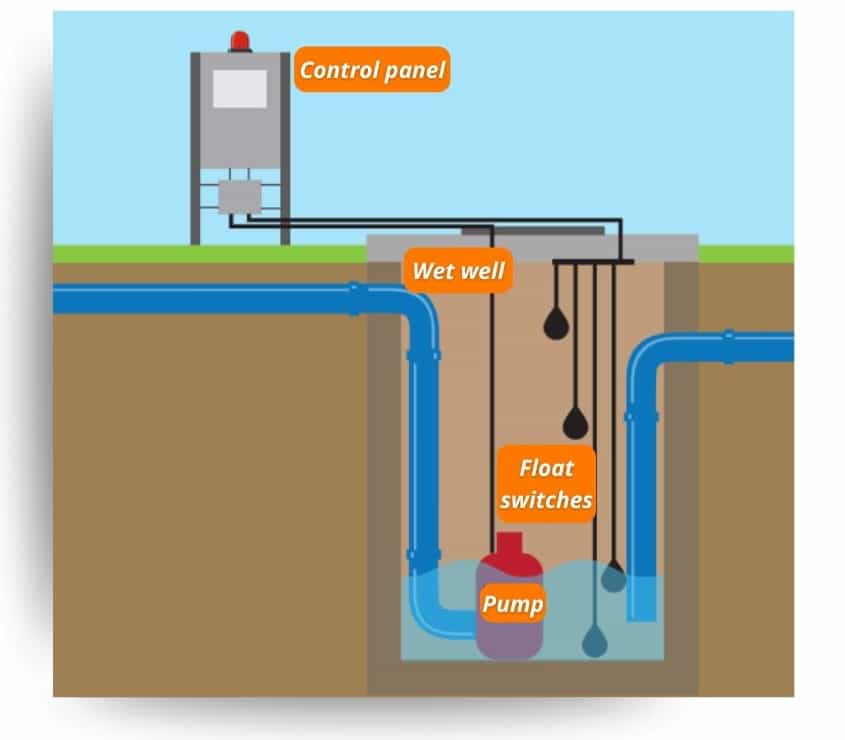If your home has a septic system, you already know it’s responsible for handling all the wastewater from your toilets, sinks, showers, and more. But not every home is built on flat land—and when gravity isn’t enough to move that water where it needs to go, that’s where a lift station comes in.
So, what is a septic system lift station, how does it work, and how do you know if yours needs attention? Let’s break it down.
The Basics
A septic system lift station is also known as a pump station. This crucial component is designed to move wastewater from lower elevations to higher ones when natural gravity flow isn’t possible.
This is particularly common in areas with uneven terrain, high water tables, or when the septic tank or drain field is situated uphill from the home. The primary purpose of a lift station is to ensure that wastewater reaches its intended destination without backups or overflows, maintaining the efficiency and safety of the entire septic system.

Parts of a Lift Station
- Wet Well: A basin where wastewater collects before being pumped out. It’s essentially a holding tank that temporarily stores sewage until it reaches a predetermined level, triggering the pumping process.
- Pumps: Submersible pumps are commonly used to move wastewater from the wet well to the septic tank or drain field. These pumps are designed to handle solids and liquids, ensuring efficient transport of sewage.
- Float Switches: These devices monitor the water level within the wet well. When the wastewater reaches a certain height, the float switch activates the pump to begin moving the sewage.
- Control Panel: This panel manages the operation of the lift station, regulating when pumps turn on and off based on input from the float switches. It also provides diagnostic information and alerts for maintenance needs.
- Alarm System: In case of malfunctions, such as pump failures or high water levels, the alarm system notifies homeowners or maintenance personnel, allowing for prompt intervention to prevent overflows or backups.
How Does a Lift Station Work?
- Wastewater Collection: Household wastewater flows into the wet well, where it’s temporarily stored.
- Level Monitoring: As the wet well fills, float switches monitor the rising water level.
- Pump Activation: Once the wastewater reaches a predetermined level, the control panel activates the pump.
- Wastewater Transport: The pump moves the wastewater through pressurized pipes to the septic tank or directly to the drain field, depending on the system’s design.
- Cycle Reset: After the water level decreases to a set point, the pump shuts off, and the cycle repeats as needed.
Why Are They Necessary?
Lift stations are indispensable in scenarios where the natural topography of the land doesn’t allow for gravity-fed wastewater movement.
For instance, if your home is located downhill from your septic tank or if the drain field is situated at a higher elevation, a lift station becomes essential. Without it, wastewater would struggle to reach its destination, leading to potential backups, overflows, and system failures.
Common Issues
- Pump Failures: Over time, pumps can wear out or become clogged, leading to system inefficiencies or failures.
- Electrical Issues: Problems with the control panel or power supply can disrupt the operation of the lift station.
- Clogs and Blockages: Introducing non-biodegradable items or grease into the system can lead to obstructions
- Alarm Malfunctions: If the alarm system isn’t working correctly, you might not be alerted to issues in a timely manner.

Maintaining Your Lift Station
- Routine Inspections. Schedule professional inspections at least once a year to assess the condition of pumps, electrical components, and other parts.
- Wet Well Cleaning. Periodically clean the wet well to prevent the buildup of solids and grease, which can lead to clogs.
- Test Alarms and Controls. Regularly test the alarm system and control panel to ensure they’re functioning properly.
- Mind What You Flush. Avoid disposing of non-biodegradable items, grease, or harsh chemicals down your drains, as these can cause blockages and damage the system.
When to Call a Professional
- If your alarm system is frequently triggered, it’s time to consult a professional.
- Strange sounds or foul smells near the lift station can indicate mechanical issues or blockages.
- If you notice slow drainage or sewage backups in your home, the lift station might be malfunctioning.
Conclusion
If your home relies on a lift station to help move wastewater, keeping it in good working order is important. Most problems can be avoided with routine maintenance and a little awareness. Pay attention to warning signs like odd smells, strange sounds, or alarms going off.
Don’t wait until something breaks to get it checked. Whether you’re new to septic systems or you’ve lived with one for years, Tampa Bay Septic is happy to help you stay ahead of problems.
